Wikipedia:Picture of the day/February 2012
|
Featured picture tools: |
These featured pictures, as scheduled below, appeared as the picture of the day (POTD) on the English Wikipedia's Main Page in February 2012. Individual sections for each day on this page can be linked to with the day number as the anchor name (e.g. [[Wikipedia:Picture of the day/February 2012#1]] for February 1).
You can add an automatically updating POTD template to your user page using {{Pic of the day}} (version with blurb) or {{POTD}} (version without blurb). For instructions on how to make custom POTD layouts, see Wikipedia:Picture of the day.Purge server cache
February 1

|
High-purity niobium crystals, with a 1 cm3 cube of anodized niobium for comparison. Niobium is a soft, grey, ductile transition metal named after Niobe from Greek mythology. Niobium is typically used in steel alloys; only a tiny amount (0.1%) is required to improve the strength of the steel. Photo: Alchemist-hp |
February 2

|
The Black Kite (Milvus migrans) is a medium-sized bird of prey easily identifiable by its angled wing and distinctive forked tail. It is widely distributed through the temperate and tropical parts of Eurasia and parts of Australasia and Oceania, with the temperate region populations tending to be migratory. Photo: Benjamint444
Recently featured:
|
February 3

|
The Pink Lady's Slipper (Cypripedium acaule) is an orchid native to eastern North America. This widespread species can be found in a wide variety of environments, from coastal plains, to pine barrens, to mountaintops. It is the provincial flower of Prince Edward Island, Canada. Photo: Sasata
Recently featured:
|
February 4
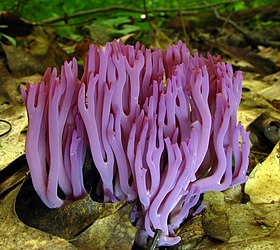
|
The violet coral (Clavaria zollingeri) is a widely distributed species of fungus with tubular, purple basidiocarps (fruit bodies) that grow in clusters up to 10 cm (3.9 in) tall and 7 cm (2.8 in) wide. It is a saprobic species, growing on the ground in woodland litter. Photo: Dan Molter
Recently featured:
|
February 5
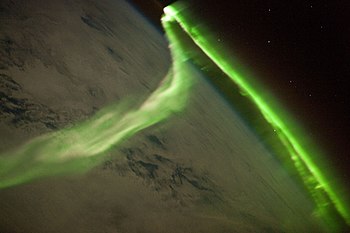
|
The aurora australis, as seen from the International Space Station. Aurorae are natural light displays in the sky caused by the collision of energetic charged particles with atoms in the high altitude thermosphere. The particles originate in the magnetosphere and solar wind and, on Earth, are directed by Earth's magnetic field into the atmosphere. Photo: NASA/ISS Expedition 23 crew
Recently featured:
|
February 6

|
Successive close-ups of the scales of a Peacock butterfly (at top) wing. Shown from left to right, top to bottom: (second row) a closeup of the scales of the specimen at top, high magnification view of coloured scales (different species); (third row) electron micrograph of a patch of wing (~×50 magnification), the scales close up (~×200); (last row) a single scale (×1000), microstructure of a scale (×5000). Photos: MichaD (top and second row left), Shaddack (second row right), SecretDisc (micrographs)
Recently featured:
|
February 7

|
The Wave (1896) by William-Adolphe Bouguereau, an example of an art nude, an art form where the naked human form is the dominant theme and is not intentionally erotic. It does not involve the subject interacting with anyone or the face of the nude as a prominent feature. The body presented is revealed as an object of art and not a person with reference to his or her social relationships and behavioral patterns.
Recently featured:
|
February 8

|
An odd-eyed cat is a cat with one blue eye and one green, yellow, or brown eye. This is a feline form of complete heterochromia, a condition also present in humans and some other animals (including horses and huskies). It can occur in a cat of any fur color, provided that it possesses the white spotting gene. Animals affected by the condition can have partial heterochromia, in which only part of the iris is a different color. Photo: Keith Kissel |
February 9
|
A panoramic view of Brandenburg an der Havel, a town in the state of Brandenburg, Germany, located on the banks of the River Havel. The town was founded by the Hevelli, a tribe of Polabian Slavs, in the 8th century, and changed hands between Germans and Slavs several times. Development was restricted to the western bank of the Havel until 1196, when it was extended to the eastern side, although the two portions were regarded as separate towns until 1715. Photo: Mathias Krumbholz
Recently featured:
|
February 10
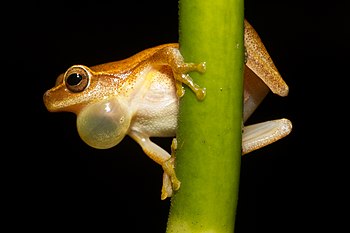
|
A male Dendropsophus microcephalus frog, displaying its vocal sac—membranes of skin under the throat or on the corner of the mouth that distend to amplify its call. The species lives in moist areas in most of Central America and northern South America. Photo: Brian Gratwicke
Recently featured:
|
February 11
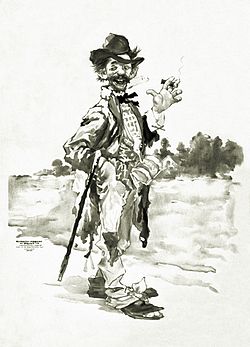
|
A romanticized depiction of a tramp smoking a cigar with a cane over his arm, from an 1899 poster. A tramp is a homeless person who travels from place to place as a vagrant, traditionally on foot. Unlike other temporarily homeless people, they do not seek out regular work and support themselves by other means such as begging or scavenging. The term "tramp" is derived from the Middle English as a verb meaning to "walk with heavy footsteps" (cf. the modern English word "trample"). Image: United States Printing Company; Restoration: Adam Cuerden
Recently featured:
|
February 12

|
Kalākaua was the last reigning king of the Kingdom of Hawaii. He was elected king after Kamehameha V died without leaving an heir, and began his reign on February 12, 1874. During his nearly 17-year rule, Kalākaua believed in the hereditary right of the aliʻi to rule, putting him in contention with the Hawaiian League, composed mostly of Americans who favored annexation of the Hawaiian islands by the United States. In 1887, he was forced to sign the Bayonet Constitution, which stripped the monarchy of much of its power. He died in 1891, and the throne passed to his sister, Liliuokalani. Photo: Unknown; Restoration: Greg L/Papa Lima Whiskey
Recently featured:
|
February 13

|
The Common Brushtail Possum (Trichosurus vulpecula) is the largest possum species and is perhaps the most widespread mammal in Australia. It grows to about 32–58 cm (13–23 in) in length, with an additional 24–40 cm (9–16 in) for its prehensile tail (seen here hanging below the branch). It is mainly a folivore, but has been known to eat small mammals such as rats. It is common in cities, having adapted well to human habitation. Photo: JJ Harrison
Recently featured:
|
February 14

|
The Peacock flounder (Bothus mancus) is a species of lefteye flounder found widely in relatively shallow waters in the Indo-Pacific. This photomontage shows four separate views of the same fish, each several minutes apart, starting from the top left. Over the course of the photos, the fish changes its colors to match its new surroundings, and then finally (bottom right) buries itself in the sand, leaving only the eyes protruding. Photo: Mila Zinkova
Recently featured:
|
February 15
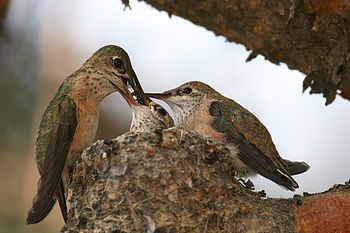
|
A female Calliope Hummingbird (Stellula calliope), the smallest bird found in Canada and the United States, feeding insects to chicks. Found mostly in western North America (although vagrants have been found in New York and Connecticut), it is migratory and winters in southwestern Mexico. Photo: Wolfgang Wander
Recently featured:
|
February 16

|
The common collared lizard (Crotaphytus collaris) is a North American lizard well known for its ability to run on its hind legs. Its length, including the tail, can reach up to 12 inches (30 cm). Its name reflects its distinct coloration, which includes bands of black around the neck and shoulders that resemble a collar. Photo: Daniel Schwen
Recently featured:
|
February 17
|
The Uluguru Mountains are a mountain range in eastern Tanzania, Africa, located 200 km (120 mi) inland from the Indian Ocean, and named after the Luguru tribe. The main portion is a ridge running roughly north–south and rising to 2,630 m (8,630 ft) altitude at its highest point. Photo: Muhammad Mahdi Karim
Recently featured:
|
February 18

|
A 1 cm3 cube, crystalline fragments, and a single crystal of tantalum, created by the floating zone process. Tantalum is a rare, hard, blue-gray, lustrous transition metal that is highly resistant to corrosion. Its main use today is in tantalum capacitors in electronic equipment. Photo: Alchemist-hp
Recently featured:
|
February 19
|
The Common Postman (Heliconius melpomene) is a butterfly species native to Central and northern South America. It has large long wings with red patterns and an orange stripe down each forewing. It is very similar to other species in its genus and can be difficult to distinguish. Photo: Richard Bartz
Recently featured:
|
February 20

|
Morchella elata is one of three edible fungus species known as the "black morel". It grows in small groups on soil in forests in North America and Europe. The fruiting body grows 5 to 10 cm (2 to 4 in) tall, with an ovoid or conical head. Photo: Dan Molter
Recently featured:
|
February 21

|
Nicholas Kratzer (1487?–1550) was a German mathematician, astronomer and horologist. Much of Kratzer's professional life was spent in England where he was appointed astronomer to King Henry VIII. Born in Munich, Kratzer came to England in 1516 and established himself as part of the artistic and scientific circle around Sir Thomas More. Kratzer tutored More's children in mathematics and astronomy and More introduced him at court in much the same way as he had their mutual friend Hans Holbein the Younger, who painted this portrait.
Recently featured:
|
February 22

|
An editorial cartoon from the New York Herald depicting (left to right) Uncle Sam, George Washington, and Theodore Roosevelt on a pier welcoming the Great White Fleet back into port. Roosevelt had ordered the fleet, which consisted of 16 battleships and various escort ships, to circumnavigate the globe as a demonstration of growing American military power and blue-water navy capability. Artist: William Allen Rogers; Restoration: Lise Broer
Recently featured:
|
February 23

|
|
A fossil of Thrissops formosus, a member of the extinct fish genus Thrissops that lived during the Jurassic and Cretaceous periods. Thrissops were fast predatory fish, about 24 inches (60 cm) long, that fed on other bony fish. They had a streamlined body with a deeply cleft tail and only very small pelvic fins. Photo: H. Zell
Recently featured:
|
February 24

|
Two specimens of Pectinaria koreni (a species of the ice cream cone worm polychaete). These worms build sand tubes that roughly resemble ice cream cones hence its name. The upper one is ensconced within its tube, and the lower one is the worm. In both pictured worms, the head is to the right. Photo: Hans Hillewaert
Recently featured:
|
February 25

|
A 360° fog bow, an optical phenomenon similar to a rainbow that occurs when a spectrum of light appears due to the Sun's rays shining through fog. Because of the very small size of water droplets that cause fog—smaller than 0.05 mm (0.0020 in)—fog bows have only very weak colors, with a red outer edge and bluish inner. In many cases when the droplets are very small, fog bows may appear white, in which case they are known as "white rainbows". Photo: Mila Zinkova
Recently featured:
|
February 26

|
The Pine Siskin (Carduelis pinus) is a finch native to northern North America. The plumage is drab, being brown on the upperparts and pale on the underparts, with heavy streaking throughout. They have yellow patches in their wings and tail, which are not always visible. They grow to 11–14 cm (4.3–5.5 in) in length and typically weigh 12–18 g (0.4–0.6 oz). Photo: Simon Pierre Barrette
Recently featured:
|
February 27
|
Time-lapse video (played at 750× true speed) of the nastic movements of an Oxalis triangularis plant. The leaves open and close in response to varying light levels with the result that they are open during the day and are closed at night. This is true movement (i.e. not growth) and is non-directional with respect to the stimulus. Video: Richard Wheeler
Recently featured:
|
February 28

|
Two Common Blue Damselflies (Enallagma cyathigerum) mating. The male clasps the female by her neck while she bends her body around to his reproductive organs; this is called a mating wheel. This damselfly species is found throughout Europe. The male is similar in appearance to the Azure Damselfly. Photo: L. B. Tettenborn
Recently featured:
|
February 29

|
A technician performs a Mantoux tuberculin test (named after its creator, French physician Charles Mantoux), which is used to evaluate people for latent tuberculosis infection. The injection causes a 6–10 mm (0.24–0.39 in) wheal (bump) and the test is evaluated by measuring the diameter of the induration (hardening of the skin) at the injection site a few days later. Photo: Greg Knobloch, CDC
Recently featured:
|
Picture of the day archives and future dates


